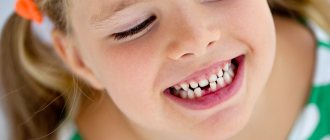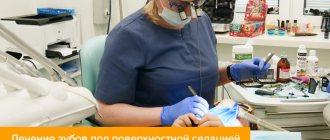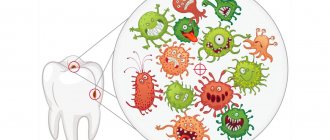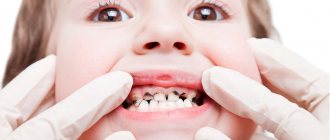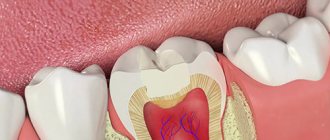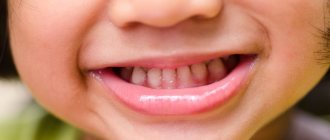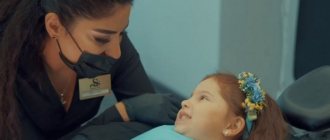“Mom, I want a big chocolate!” - the three-year-old child bursts into loud hysterics throughout the store. The blushing mother, embarrassed in front of the public, hastily buys what she needs. The situation repeats itself constantly and is aggravated, moreover, by the love of adults who strive to treat the baby with something tasty. And after a while, the baby begins to complain of toothache... But sweets are only one of the reasons why caries occurs in children’s baby teeth; Olga Dzedzits, a leading specialist in pediatric dentistry at Inpromed in Moscow, told us about other possible reasons.
How to identify milk caries?
It is quite simple to identify caries in young and older children. White or brown spots appear on the teeth, a painful reaction to hot and cold is observed, and the child may develop bad breath. When these first symptoms of caries appear, it is already worth sounding the alarm, since the carious process is developing very rapidly. It is characterized by almost instantaneous damage to several teeth, and if measures are not taken, the entire dentition may be affected. Of course, it is often difficult for a child to articulate that his baby tooth hurts. He may refuse to eat or chew on only one side. This should also alert parents and encourage them to take their child to pediatric dentistry.
Treatment of caries without a drill
Modern pediatric dentistry offers treatment of caries without the use of a drill:
- Silvering . This method is excellent for treating initial caries. The dentist cleans the affected surface and treats it with a 30% silver nitrate solution, after which a protective film is formed that prevents the further development of caries. The procedure takes only a few minutes and is absolutely painless and non-toxic for the baby.
- Remineralization . The procedure is aimed at restoring the mineral composition of enamel and dentin.
- Ozone therapy also makes it possible to treat initial caries without preparation. The method is based on the destruction of carious lesions using ozone molecules.
- Laser treatment of caries has been successfully used in pediatric dentistry. The treatment is painless and does not require anesthesia.
- Chemicals . Treatment is carried out without a drill; the doctor removes damaged tissue using a special gel.
- Icon is a modern method of treating initial caries. To prevent the development of caries, the affected area is sealed using a special polymer.
What are the causes of caries in primary teeth?
There are more reasons for caries of baby teeth in children than meets the eye. This includes improper oral hygiene, sharing cutlery with adults who have caries, and much more. However, the main causes of occurrence are the influence of consumed carbohydrates that destroy the tooth, accidental infection from a carrier of a carious infection, a genetic factor, the immaturity of the children's skeletal system, and improper use of pacifiers and nipples.
- Of course, the main and most common cause of caries in primary teeth in children is poor oral hygiene and the influence of sweets. According to statistics, caries develops in young children in 73% of cases. Sucrose, glucose and fructose are the acids that are formed during the fermentation of carbohydrates and lead to the destruction of enamel. Immediately after ingestion of carbohydrates, the pH of saliva decreases from 6 to 4, and pathogenic bacteria settle in food debris that is not cleaned from the teeth.
- Remember the children's saying “from mouth to mouth you get a germ”? It turns out that she is not so far from the truth. The fact is that caries is an infection, an infection. That is, a loving parent, being a potential carrier of carious microbes, does not even suspect that by kissing his baby or sharing dinner with him, he can personally infect his child!
- Another reason why caries may occur on baby teeth is genetic. Teeth begin to form during the prenatal period, in the first trimester of pregnancy. Therefore, smoking by a negligent parent, her illnesses suffered during this period, or taking medications can lead to disruption of the proper development of the child’s teeth.
- Childhood caries of primary teeth may be associated with the following factor: children’s teeth have a low degree of mineralization and erupt “immature”, and only then “mature” in the oral cavity. Final mineralization lasts for one and a half to two years for baby teeth and about three years for permanent ones. Pediatric dentists call such periods of “maturation” the most susceptible to caries. Therefore, the reasons why caries occurs in primary teeth at an early age may also be chronic diseases, the effects of medications, the composition of saliva and the fluoride content in water and food.
- Another cause of caries of primary teeth in young children is improper use of pacifiers. A baby who falls asleep with a bottle in his mouth runs the risk of getting caries on his front teeth, so-called bottle caries. In this case, prolonged contact of the sweet liquid with the teeth leads to caries of all front teeth. In this case, the disease spreads around the entire visible part of the tooth along the perimeter.
As you can see, there are more than enough reasons for the appearance of childhood caries in baby teeth. But they all boil down, as a rule, to demineralization of teeth and destruction of hard tissues. Characteristic changes occurring in teeth can only be diagnosed by a dentist. Further treatment will depend on how severe the caries has developed. What are the stages of development of caries in primary teeth?
How is teenagers' teeth treated?
Dental treatment for adolescents is very different from the work carried out by dentists at the Dentville clinic with adult patients:
- When pulpitis occurs in children, it is important not only to remove the inflamed bone tissue - you must not damage the root of the tooth, because otherwise it may stop growing and last less than its “healthy” counterparts.
- Removal of tooth tissue is difficult due to the thinness of the enamel.
- You cannot have implants installed before you reach 18 years of age. Therefore, tooth extraction can be performed in adolescents in exceptional cases. This can lead to problems with bite, gaps between teeth, etc. Unfortunately, these processes occur very quickly in children and adolescents.
The Dentville clinic employs only experienced specialists, and our equipment is modern and innovative. Even in the most difficult cases, for example, with a dislocated tooth or irreversible pulpitis, our doctors will be able to find a way to save a child from dental problems and return him to the ability to smile beautifully!
Stages of caries of primary teeth
Dentists distinguish the following stages of caries of primary teeth in children:
- Elementary;
- Surface;
- Average;
- Deep;
Initial caries of primary teeth
Initial caries of baby teeth can be recognized as follows: white spots of different shapes and sizes appear on the enamel, but there is no pain. In an “advanced” case, the initial caries progresses - the spots darken, becoming brown and then black.
Superficial caries of primary teeth
With superficial caries of primary teeth, the dental tissue defect is located within the enamel, and the carious cavity can be either light or dark. However, in this case, pain occurs when the tooth comes into contact with sweet, sour or salty foods. In this case, treatment of the baby tooth and filling of the cavity is already required.
Average caries of primary teeth
Average caries of primary teeth affects the enamel and internal dental tissue, dentin. In addition to the unpleasant sensations from sweet, sour and salty, pain from hot and cold is added. In this case, just as with superficial caries of primary teeth, filling is necessary.
Deep caries of baby teeth
With deep caries of primary teeth, the enamel and a significant part of the dentin are affected. If treatment is not carried out at this stage, then caries can affect the pulp of the tooth and then reach the root, often causing a cyst in baby teeth. Here you just need to see a doctor before the infection goes further. In this case, severe caries of primary teeth and its treatment will depend on how deep the caries has spread.
Features of dental treatment for teenagers
Dental treatment for a teenager is more complicated because for a good result it is necessary to take into account the characteristics of the teeth and the development of caries in this age group. The extent of treatment depends on the depth of damage to permanent teeth:
- The initial stage (“white spot” without a carious cavity) is a set of measures that combines high-quality daily oral hygiene at home, the use of topical agents that increase the resistance of tooth tissue in the dentist’s office and a balanced diet.
- Superficial caries - treatment is carried out by filling. The child must be able to brush his teeth properly and eat rationally.
- Uncomplicated caries - replacement of mineral elements lost by enamel during the period of partial demineralization while maintaining the organic enamel matrix, filling.
- Medium caries - therapeutic measures are aimed at relieving pain, removing necrotic tissue from the carious cavity, restoring the anatomical shape and normal function of the tooth.
- Deep caries - implies the use of therapeutic pads, preparation of the carious cavity, removal of softened dentin and a complex set of local and general manipulations, carried out in strict sequence and under conditions of maximum anesthesia [2].
Is caries treated in baby teeth?
Is it necessary to treat caries on baby teeth? This question still remains open for some parents. Even knowing that the child has caries, they are in no hurry to see a doctor, thinking as follows: “the milk teeth will fall out anyway.” Such judgments are absurd, because infected baby teeth will lead to complications in the growth of permanent teeth or provoke an exacerbation of other diseases in the baby’s body. One way or another, you will have to remove the baby tooth ahead of time. Caries in pediatric dentistry is considered one of the most common diseases, so both parents and specialists should ask the question “why is it necessary to treat caries of primary teeth?” Dentists believe that treatment of caries in a baby tooth will preserve it until the “arrival” of the molars.
Common diseases
Caries
. It begins with demineralization and softening of tooth enamel and the appearance of white spots on the surface of the temporary tooth. Initial caries of primary teeth in the stain stage begins to develop in children from 2 years of age. If carious spots are not treated, the enamel cracks and the infection spreads to the dentin, causing medium and deep caries.
Pulpitis
. It is a complication of deep caries and is characterized by inflammation of the nerve of the baby tooth. Characterized by acute pain and fever. The disease is typical for children over 4 years of age.
Periodontitis
. It occurs against the background of deep caries and pulpitis if you do not consult a doctor in a timely manner. Periodontitis of a baby tooth is very dangerous, as it can damage the germ of a permanent tooth.
Treatment of caries of primary teeth in children
If the doctor finds that a child has incipient caries, then most likely, treatment of baby teeth will not be required. The specialist will protect the enamel from further destruction using a painless and effective procedure - applying fluoride varnish or a silver fluoride compound. Then, when the baby gets permanent teeth, the dentist can seal the fissures - the depressions between the elevations of the tooth - which will prevent the occurrence of bacterial plaque that destroys the enamel. If caries progresses, you can no longer do without filling. The doctor will quickly and almost painlessly remove the affected tissue and hermetically seal the tooth. Otherwise, caries can develop into pulpitis in a child, and then into periodontitis.
Stages of treatment of caries of primary teeth
- Before administering anesthesia, the doctor must numb the injection site using special gels or spray. Moreover, the content of the anesthetic component should be minimal. Anesthesia is, as a rule, carried out only in cases where pulp removal is required - that is, with medium and deep caries of primary teeth.
- It is advisable to remove affected tissue using hand tools or a drill, taking frequent breaks.
- As fillings, materials that can be applied “one time” should be used in order to reduce the operation time.
- If a child has deep caries of primary teeth and its treatment requires the necessary filling of the roots, then the canals are disinfected without special mechanical treatment and filled with a special paste.
- Treatment of baby teeth in children should take no more than half an hour, otherwise the child will get tired.
- Treatment of severe caries of primary teeth, as a rule, takes place in several stages and requires the use of sedation.
- Dental treatment under general anesthesia in children is carried out strictly according to indications;
You can get rid of carious lesions at the initial stage using modern methods of caries treatment without a drill. Comfortable, painless treatment is suitable for those children who are afraid of manipulation with a dental bur. The cost of treating caries in baby teeth without a drill is slightly higher than the price of traditional dental treatment for children, but it is worth it. If simple caries gives complications, then you will have to resort to classic drilling. The cost of treatment of complicated caries of primary teeth will depend on the degree of neglect of the disease.
How does the treatment of pulpitis of permanent teeth in children and adolescents differ from the treatment of adults?
Newly erupted “young” permanent teeth do not yet have formed roots. Therefore, if pulpitis in a teenager is to be treated, the doctor must first find out, using x-rays, whether the roots of the diseased tooth have formed or not. If the roots are not formed, then the treatment of the tooth canals is carried out as sparingly as possible.
Unfortunately, the method of partial removal - amputation of the pulp, which is often described on dental websites as acceptable in this case, does not work well in practice. It gives too many complications and a 100% guarantee that the tooth canals will need to be re-treated, so this method of treatment is practically not used in our clinic.
You also need to remember that if you do not seek dental care in a timely manner or if a doctor makes a mistake, pulpitis in adolescents quickly becomes complicated and turns into purulent forms, periodontitis (inflammation of the tissues surrounding the tooth) and even sepsis (blood poisoning).
Prevention of caries in children
Prevention of childhood caries includes several areas, which boil down to proper nutrition, as well as home and professional hygiene.
- Individual oral hygiene. Home hygiene means that as soon as the first tooth hatches, a brush for the baby should appear in a glass next to the parents’ brushes. The same applies to toothpaste. At first, the paste can be applied to gauze or a fingertip to clean your teeth so as not to injure your delicate gums. You need to clean your teeth from all surfaces vertically, then wipe them with a brush soaked in water. Thus, firstly, plaque will be removed, and, secondly, parents will teach the baby to take care of the oral cavity.
- Prevention of caries with the help of a well-chosen diet. As for nutrition, parental duty is to breastfeed the baby from the very beginning. There is no need to talk about the beneficial properties of breast milk, and the sucking process greatly affects the developing jaw system. Then the baby should be accustomed to fermented milk products. By six months, the child should be fed kefir, and later - cottage cheese and cheese. Parents should remember that the main formation and formation of permanent teeth occurs up to 3 years. This means that calcium must always be present in the daily diet.
- Professional oral hygiene. This type of prevention involves periodic visits to the dentist and hygienist. The first visit should occur on your first birthday. The specialist will not only give recommendations for care, but also create a diet regimen and examine the mouth. When the first teeth emerge, you and your child will be shown how to brush their teeth properly at an appointment with a hygienist. If there is a problem such as tartar in children, you cannot do without professional hygienic cleaning. It is important for parents to make it a rule to visit the doctor twice a year. And if there are problems with teeth, then more often - once every three months. This is largely due to the fact that various pathologies develop too quickly in childhood. Meanwhile, early diagnosis will lead to quick, painless and relatively inexpensive treatment of caries.
As you can see, in most cases, when caries can attack children's teeth, parents are able to rebuff it decisively. Of course, there is no escape from genetic predisposition. But it’s not without reason that dental experts say that sweets are the main cause of the development of the disease! So isn’t it better to eliminate the constant source of bacteria and, instead of harmful carbohydrates, offer the child fruits, which are much healthier, after the main meal? Ultimately, your child will thank you in the future for being vigilant and maintaining healthy teeth!
Make an appointment
right now!
Dzedzits Olga Alekseevna
Surgeon, Therapist, Pediatric dentist, Hygienist
Causes of caries in adolescents
Caries in all people, regardless of age, develops due to the active reproduction of cariogenic bacteria in the oral cavity. They process the sucrose contained in foods and release harmful acids that corrode the enamel, leaching calcium and fluoride from it. Due to demineralization, it becomes loose and porous, and therefore gradually collapses and exposes the internal tissues of the tooth - dentin.
Cariogenic microbes are most dangerous in the following cases:
- The teenager neglects hygiene rules, rarely brushes his teeth or does it incorrectly.
- The teeth grow too crowded, they have deep, narrow fissures and other features that create places in the oral cavity that are difficult to reach with a toothbrush.
- The child eats a lot of sweets and chips, and often drinks carbonated drinks that contain sugar.
- A teenager has a genetic predisposition to dental diseases, congenital abrasion of enamel, etc.
- Hormonal imbalances that lead to a weakened immune system, making it unable to fight germs.
- The body lacks the minerals that are responsible for the condition of the enamel.
Often, for a carious process to occur, several factors are enough: poor hygiene and poor nutrition.
Caries on the front milk teeth - what to do?
On the front milk teeth, caries occurs almost as often as on the lateral ones. What should the child’s parents do in such cases? Be sure to take him to the dentist, regardless of the stage of the disease. Even if you notice a white spot on your baby’s front teeth, do not delay visiting the doctor to avoid further development of caries, its complications and other unpleasant consequences that pose a threat to the health of the child’s future permanent teeth.
Caries of primary teeth and its ENT complications
Sometimes parents unsuccessfully try to understand why their child often suffers from colds, complains of ear pain, and suffers from a chronic runny nose. And few people realize that the reason for weakened immunity lies in the baby’s untreated teeth. How can this be? It turns out that it’s all about pathogens! Caries develops under the influence of pathogenic bacteria, which can also cause diseases of the gastrointestinal tract and respiratory system of the child. Therefore, timely treatment of caries is important, including for maintaining the normal functioning of other organs of the baby.
Do baby teeth hurt due to caries?
Painful sensations when the surface of the teeth comes into contact with sweet, sour or salty food irritants is one of the first signs of incipient caries on baby teeth. Further, the discomfort in the affected teeth will only intensify, and when caries affects the pulp, the teeth begin to hurt like adults. In addition to acute pain, this stage of the disease is characterized by a high risk of premature removal of a baby tooth.
Publisher: Expert magazine about dentistry Startsmile.ru

